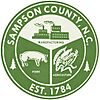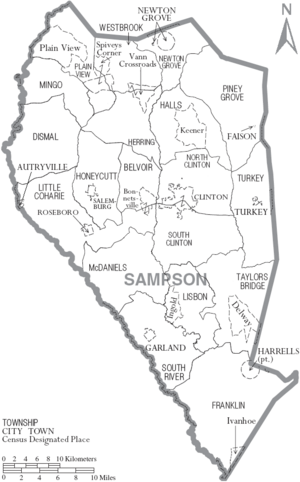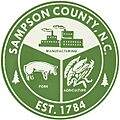Sampson County, North Carolina facts for kids
Quick facts for kids
Sampson County
|
|||
|---|---|---|---|
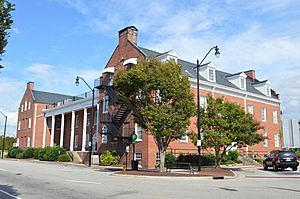
Sampson County Courthouse in Clinton
|
|||
|
|||
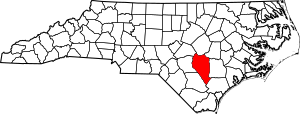
Location within the U.S. state of North Carolina
|
|||
 North Carolina's location within the U.S. |
|||
| Country | |||
| State | |||
| Founded | 1784 | ||
| Named for | John Sampson | ||
| Seat | Clinton | ||
| Largest community | Clinton | ||
| Area | |||
| • Total | 947.83 sq mi (2,454.9 km2) | ||
| • Land | 945.93 sq mi (2,449.9 km2) | ||
| • Water | 1.90 sq mi (4.9 km2) 0.20% | ||
| Population
(2020)
|
|||
| • Total | 59,036 | ||
| • Estimate
(2023)
|
59,601 | ||
| • Density | 62.41/sq mi (24.10/km2) | ||
| Time zone | UTC−5 (Eastern) | ||
| • Summer (DST) | UTC−4 (EDT) | ||
| Congressional district | 3rd | ||
Sampson County is a county located in the state of North Carolina, USA. In 2020, about 59,036 people lived there. The main town and county seat is Clinton.
Contents
History of Sampson County
How Sampson County Was Formed
Sampson County was created in April 1784. This happened after the American Revolutionary War. The North Carolina General Assembly took land from nearby Duplin County. Later, land from Wayne County and New Hanover County was also added.
Early Settlers and Communities
Many of the first settlers were Scots-Irish immigrants. They came from Northern Ireland to colonial North Carolina. Some of the earliest settled areas included Taylors Bridge. Pioneer families lived there as early as the 1730s or 1740s. These families included Matthis, Johnson, Robinson, and Register. Later, people from a Swiss colony in New Bern also joined them. Pioneers from northern states like New Jersey and Connecticut arrived too.
John Sampson and Richard Clinton
One of the first European settlers was John Sampson. He was the first Register of Deeds for Duplin County. He also served as a military leader. Sampson was later elected the first mayor of Wilmington. He brought Richard Clinton with him, who was believed to be his stepson.
Richard Clinton became important in government and the military. He was the Register of Deeds for Duplin County for ten years. He was also elected to the North Carolina Provincial Congress. In 1776, Clinton formed a group of soldiers to defend Wilmington. He later became a Colonel and then a Brigadier General.
When North Carolina formed its state government, Clinton was elected to the North Carolina General Assembly. He represented Duplin County until Sampson County was created in 1784. Clinton helped pass the law to create the new county. He suggested naming it "Sampson" to honor his stepfather, John Sampson.
Native American History
In 2000, the Coharie Intra-tribal Council, Inc. had 1,029 members in Sampson County. This is a state-recognized tribe. They say they are descendants of Native American tribes from North Carolina's coast.
Some people in the early 1900s claimed that the "Croatan Indians" of Sampson County were mixed-race. They believed these people were descendants of English settlers from the Lost Colony of Roanoke Island. However, most historians do not agree with this idea. There is no proof of English settlements inland before 1703. Also, DNA analysis has not supported these claims.
Geography and Nature
Sampson County's Location
Sampson County covers about 947.83 square miles. Most of this is land, with only a small part being water. It is the second-largest county in North Carolina by land area.
Rivers and Creeks
The county is home to parts of the Black River and South River. It also has Six Run Creek. The Black River is famous for having some of the oldest bald cypress trees. One tree is over 2,600 years old!
Other important water bodies include:
- Bulltail Creek
- Great Coharie Creek
- Little Coharie Creek
- Mingo Swamp
Nearby Counties
Sampson County shares borders with these counties:
- Johnston County – to the north
- Wayne County – to the northeast
- Duplin County – to the east
- Pender County – to the southeast
- Bladen County – to the southwest
- Cumberland County – to the west
- Harnett County – to the northwest
Major Roads and Transportation
Many important highways pass through Sampson County. These include:
 I-40
I-40


 Future I-795
Future I-795 US 13
US 13


 US 117 Conn.
US 117 Conn. US 421
US 421 US 701
US 701 NC 24
NC 24
 NC 24 Bus.
NC 24 Bus. NC 41
NC 41 NC 50
NC 50 NC 55
NC 55 NC 96
NC 96 NC 242
NC 242 NC 403
NC 403 NC 411
NC 411 NC 903
NC 903
The Clinton-Sampson County Airport is also located here. It is used for public flights and is owned by the city and county.
People and Population
| Historical population | |||
|---|---|---|---|
| Census | Pop. | %± | |
| 1790 | 6,162 | — | |
| 1800 | 6,719 | 9.0% | |
| 1810 | 6,620 | −1.5% | |
| 1820 | 8,908 | 34.6% | |
| 1830 | 11,634 | 30.6% | |
| 1840 | 12,157 | 4.5% | |
| 1850 | 14,585 | 20.0% | |
| 1860 | 16,624 | 14.0% | |
| 1870 | 16,436 | −1.1% | |
| 1880 | 22,894 | 39.3% | |
| 1890 | 25,096 | 9.6% | |
| 1900 | 26,380 | 5.1% | |
| 1910 | 29,982 | 13.7% | |
| 1920 | 36,002 | 20.1% | |
| 1930 | 40,082 | 11.3% | |
| 1940 | 47,440 | 18.4% | |
| 1950 | 49,780 | 4.9% | |
| 1960 | 48,013 | −3.5% | |
| 1970 | 44,954 | −6.4% | |
| 1980 | 49,687 | 10.5% | |
| 1990 | 47,297 | −4.8% | |
| 2000 | 60,161 | 27.2% | |
| 2010 | 63,431 | 5.4% | |
| 2020 | 59,036 | −6.9% | |
| 2023 (est.) | 59,601 | −6.0% | |
| U.S. Decennial Census 1790–1960 1900–1990 1990–2000 2010 2020 |
|||
Population in 2020
In 2020, Sampson County had 59,036 people. There were 23,416 households and 15,705 families.
| Race | Number | Percentage |
|---|---|---|
| White (non-Hispanic) | 29,729 | 50.36% |
| Black or African American (non-Hispanic) | 13,944 | 23.62% |
| Native American | 1,002 | 1.7% |
| Asian | 216 | 0.37% |
| Pacific Islander | 18 | 0.03% |
| Other/Mixed | 1,878 | 3.18% |
| Hispanic or Latino | 12,249 | 20.75% |
Population in 2010
In 2010, the county had 63,431 people. The population density was about 67 people per square mile. About 25.8% of the population was under 18 years old. The median age was 35 years.
Sampson County is also a major producer of hogs. It has over 2 million hogs, making it second in the state for hog production.
Economy and Jobs
Farming and Industry
Sampson County has always been an agricultural county. Farming is still one of the most important parts of its economy. In the past, industries like naval stores (products from pine trees) and timber were also big. After the American Civil War, these industries slowed down. This was partly because enslaved people gained their freedom, changing the labor force.
Now, the county has more manufacturing and service industries. Over half of the county's land is used for farming. Many different crops are grown, including vegetables, fruits, tobacco, peanuts, corn, and soybeans.
Leading Agricultural Products
As of 2012, Sampson County is the largest producer of hay and flue-cured tobacco in North Carolina. It is also the largest producer of turkeys. The county is the second largest producer of hogs in the state.
Education and Learning
Public Schools
Sampson County has a public school system for grades K-12. The city of Clinton has its own separate school district.
County Schools
- Elementary Schools
- Clement
- Hargrove
- Hobbton
- Midway
- Plain View
- Roseboro
- Salemburg
- Union
- Intermediate School
- Union
- Middle Schools
- Hobbton
- Midway
- Union
- Roseboro-Salemburg
- High Schools
- Union
- Hobbton
- Midway
- Lakewood
- Sampson Early College High School
Clinton City Schools
- Elementary Schools
- Butler Avenue
- L.C. Kerr
- Sunset Avenue
- Middle School
- Sampson
- High School
- Clinton
Colleges and Libraries
The only public college in the county is Sampson Community College.
The Sampson County Library System serves residents with four libraries. They also have a service for people who cannot visit the library. The libraries offer online resources like eBooks, audiobooks, and genealogy databases. They also provide computer classes and Story Time programs.
Library Locations
- J.C. Holliday Library (Clinton)
- Bryan Memorial Library (Newton Grove)
- Miriam Lamb Memorial Library (Garland)
- Roseboro Public Library (Roseboro)
The J.C. Holliday Library in Clinton is the main library. It has the largest collection of books and research materials. It also has a special collection on local history and family research.
Communities in Sampson County
City
- Clinton (This is the county seat and the largest community.)
Towns
Census-Designated Places (CDPs)
These are areas that are like towns but are not officially incorporated.
Other Communities
These are smaller, unincorporated communities:
- Moltonville
- Rebel City
- Suttontown
Notable People from Sampson County
Many interesting people have come from Sampson County, including:
- Micajah Autry: A merchant and lawyer who died at the Battle of the Alamo.
- Theophilus H. Holmes: A US Army officer and Confederate general during the American Civil War.
- James Kenan: A military leader in the American Revolutionary War and an early senator for North Carolina.
- Robert Herring Wright: The first president of East Carolina University.
- Marion Butler: A US Senator from North Carolina (1895-1901).
- Lauch Faircloth: A US Senator (1993-1999).
- Gwendolyn Faison: A former mayor of Camden, New Jersey.
- Gabriel Holmes: The 21st governor of North Carolina.
- Rufus G. Herring: A US Naval Reserve Officer who received the Medal of Honor in World War II.
- William R. King: A politician who served in the US House and Senate. He was elected the 13th US Vice-President in 1852.
- John Merrick: An African American businessman who founded the North Carolina Mutual Life Insurance Company.
- Curtis Smith: A World Champion and Hall of Fame Drag Racer.
- Willie Weeks: A famous American Bass Guitarist and Musician.
Images for kids
See also
 In Spanish: Condado de Sampson para niños
In Spanish: Condado de Sampson para niños


